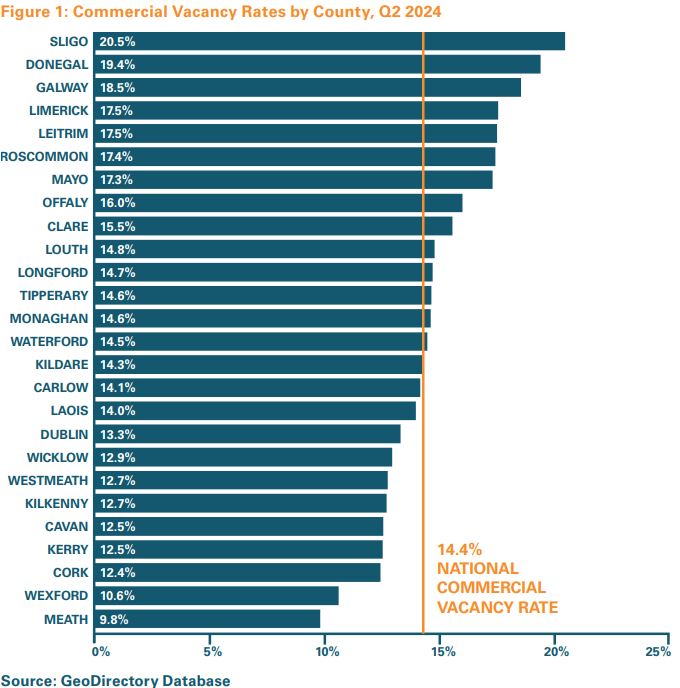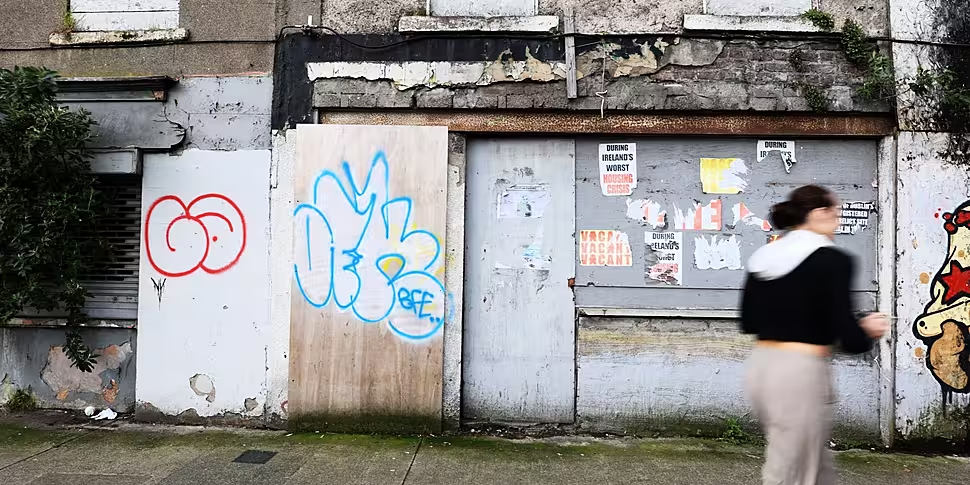High rates of vacant commercial properties are contributing to poorer health and anti-social behaviour in towns and cities across the country, a leading architect has warned.
New GeoDirectory data shows the national commercial vacancy rate stood at 14.4% in the second quarter of this year.
That's an increase of 0.3% on the same period last year.
Some 30,246 commercial properties were classified as vacant in June 2024, with vacancy rates increasing in 14 out of 26 counties surveyed.
The highest commercial vacancy rates were in the west of the country, with Sligo (20.5%), Donegal (19.4%) and Galway (18.5%) recording the highest proportion of vacant properties.
 Commercial vacancy rates. Source: GeoDirectory
Commercial vacancy rates. Source: GeoDirectoryMeath (9.8%) was the county with the lowest commercial vacancy rate, followed by Wexford (10.6%) and Cork (12.4%).
Architect Roisin Murphy told Newstalk Breakfast people's health can suffer.
"It is very stark and even as far back as 2016, we know that vacancy has been on the increase," she said.
"We also know that it has [a] measured impact on our health, believe it or not - vacancy can even lead to disease.
"Vacancy is bad for the community [on] so many levels that it really needs to be addressed. It's a huge issue within cities."
'You still have an obligation'
Ms Murphy said anyone who owns a derelict building has an obligation on its upkeep.
"The thing that really enrages me is this goes across from OPW buildings, right down the line to somebody who's abandoned a building, that they don't come back and garden it," she said.
"Get rid of the weeds, maintain it - if you're not in your building, you still have an obligation to the people around you to maintain that building.
"It' incredibly important and you can see that [in] the gross dereliction that goes with some of the vacancy.
"It should be challenged at Government level".
'Anti-social behaviour'
In Dublin, the commercial vacancy rate was 13.3% - an increase of 0.2 percentage points compared to the previous year. Dublin 2 was the area with highest vacancy rate in the capital at 17.8%.
Ms Murphy said it is particularly evident in the city centre.
"You can see huge tranches, even in the fruit and veg market in the Iveagh Markets we've had it where to get people to even maintain the properties is very difficult," she said.
"Whatever about leaving vacant, they attract anti-social behaviour.
"I would say one of the main significant factors in the rise of anti-social behaviour is abandoned buildings in the streets."
'Conservation issues'
Ms Murphy said there are issues with enforcing orders on owners.
"The problem is [that] we still have a problem with enforcement in Dublin," she said.
"You can write a letter to somebody and say 'You're building's falling down' [but] they don't seem to be able to enforce some of the conservation issues that we're finding.
"We're finding conservation officers, basically, with their hands tied.
"We're not just talking about Georgian or Victorian buildings; we're talking about huge tranches of industrial wasteland and stuff like that."
Ms Murphy added that there is also an "opportunity for us" to "reimagine the city and reimagine a sense of how we live".
Listen back here:








